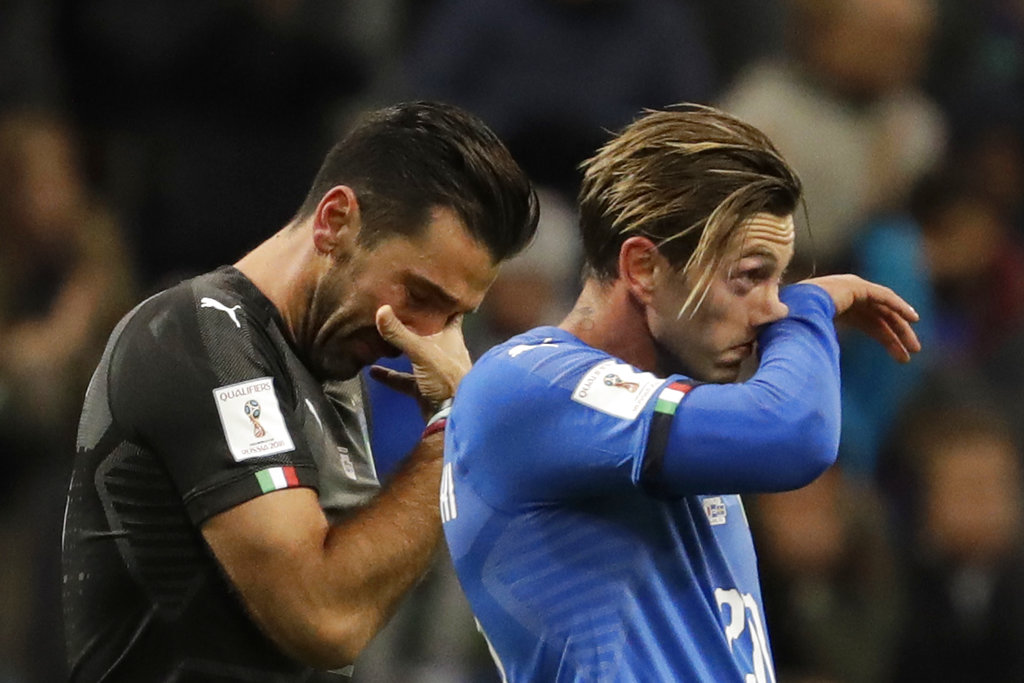
Italy’s goalkeeper Gianluigi Buffon, left, and Manolo Gabbiadini react to their team’s elimination in the World Cup qualifying play-off second leg soccer match between Italy and Sweden, at the Milan San Siro stadium, Italy, Monday, Nov. 13, 2017. (AP Photo/Luca Bruno)
ROME — The best players in the world go elsewhere. The best coaches in Italy emigrate. The stadiums around the country are falling apart.
The lingering problems affecting Italy’s domestic league might just be the reason for the country’s failure to qualify for next year’s World Cup.
The Italian league was once where the likes of Diego Maradona, Marco van Basten and Ruud Gullit came to play in the primes of their careers. It’s where Kaka won the Ballon d’Or award with AC Milan in 2007 — the last time anyone besides Lionel Messi or Cristiano Ronaldo claimed the honor.
Paradoxically, the start of Italy’s decline can be traced back to 2006 — the year Italy won its fourth World Cup. That was also the year of the “Calciopoli” refereeing scandal that saw Juventus stripped of two Serie A titles and relegated to the second division as punishment.
A number of top players left Juventus after the scandal and the “Old Lady” of Italian soccer required half a dozen years to recover.
In the meantime, the Premier League emerged as the sport’s richest domestic competition while Italy was eliminated in the first round of the last two World Cups.
The Premier League is where former Italy coach Antonio Conte now manages at Chelsea, having won the league in his first season. It’s where Carlo Ancelotti and Roberto Mancini also won titles at Chelsea and Manchester City, respectively.
Fabio Capello coached England from 2008-12 and said he would never be interested in leading Italy’s
national team.
Any Italian coach who moves to England raves about the facilities there and the packed stadiums. It’s the complete opposite of Serie A, where most of the big squads play in dilapidated stadiums that were last renovated for the 1990 World Cup — the last major tournament that Italy hosted.
Of Italy’s six biggest clubs — Juventus, Milan, Inter Milan, Roma, Lazio and Napoli — only Juventus has a new stadium that it operates on its own.
Milan and Inter play in the city-run San Siro, Roma and Lazio play in the Stadio Olimpico run by the Olympic committee and Napoli plays in the crumbling San Paolo Stadium.
Complicated laws and a lack of funding have prevented clubs from building new stadiums. In 2014, the American owners of Roma presented plans for a new stadium but haven’t been able to break ground yet due to a series of bureaucratic delays.
“It’s time to make choices that perhaps in the past people didn’t have the courage to make,” Italian Sports Minister Luca Lotti said. “This world needs to be revised from the youth levels on up to Serie A.”
Although Italy is no longer the draw it was once for the best in the world, it still has a large contingent of foreign-born players. And that is stunting the development of the country’s talent.
Juventus has been the Champions League runner-up in two of the past three seasons, but the Turin squad has heavily relied on Argentine forwards for its success: Carlos Tevez, Gonzalo Higuain and Paulo Dybala.
Federico Bernardeschi, one of Italy’s most talented young forwards, joined Juventus in a 40 million euro ($47 million) transfer this season but has been largely relegated to the bench. So it’s no wonder that Italy coach Gian Piero Ventura used Bernardeschi only in a bench role in the playoff loss to Sweden on Monday.
The only Italian who starts for Serie A leader Napoli is winger Lorenzo Insigne, who was also reduced to a
bench role under Ventura in a widely criticized decision.
Meanwhile, Napoli’s Brazilian-born midfielder Jorginho was given his first competitive start for Italy in the second leg of the playoff. Eder, another Brazilian-born player, appeared in the first leg.
With captain Gianluigi Buffon, defender Andrea Barzagli and midfielder Daniele De Rossi having announced their international retirements, Italy needs a new generation of Azzurri to step up.
And the younger players need space in an improved Serie A to become competitive.

